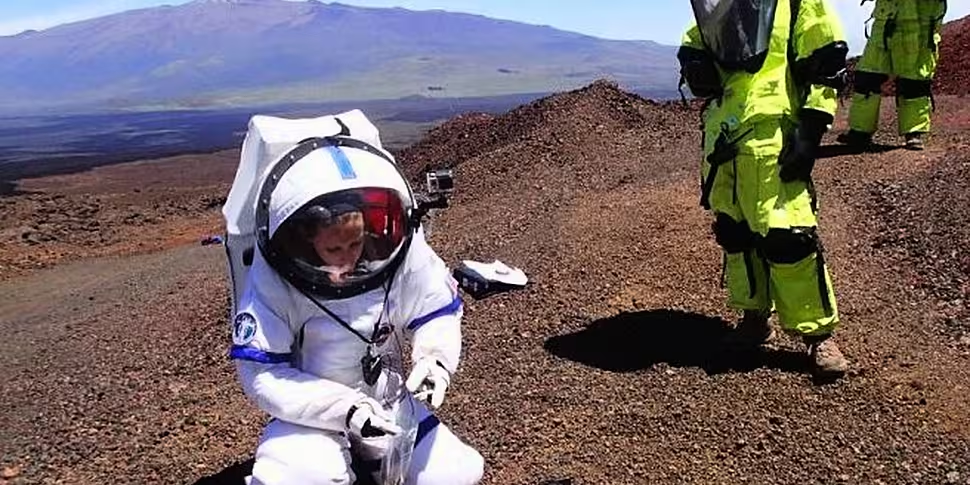A crew of NASA researchers will begin an eight-month mission to an isolated dome on a Hawaiian volcano today to study human behaviour and performance for long-term space exploration - including a planned voyage to Mars.
The NASA-funded research from the University of Hawaii will provide the six chosen crew-members with no physical contact with the outside world and a 20-minute delay in all outside communications.
The isolated and confined conditions of the operation have been designed to simulate a “planetary surface exploration mission” - as a potential future journey to the Red Planet grows ever-more feasible.
The team will be required to wear space-suits every time they exit the isolated geodesic dome on the big island’s Mauna Loa volcano.
The Hawaii Space Exploration Analog and Simulation (HI-SEAS) facility has been contributing to NASA’s plans for long-duration space exploration since 2012.
Humanity's journey to Mars
“We are an international collaboration of crew, researchers and mission support and I’m proud of the part we play in helping reduce the barriers to a human journey to Mars,” said University of Hawaii professor, Kim Binsted.
The study will assess the psychological difficulties associated with living in isolated and confined conditions far away from home.

Image: HI-SEAS.org
The crew will perform exploration tasks including geological fieldwork and life systems management - while participating in eight primary and three opportunistic research studies under the watchful eye of an experienced mission control team.
"We're hoping to figure out how best to select individual astronauts, how to compose a crew and how to support that crew on long-duration space missions," Professor Binsted told the Associated Press.
She said the study’s goal is to "reduce the barriers to a human journey to Mars."
Simulating the Red Planet
The crew-members will only be able to prepare food from “shelf-stable ingredients” and will exercise, perform research and carry out fieldwork based on NASA’s planetary exploration expectations.
There are a number of other Mars simulation projects around the world, but the Hawaii project has been receiving federal funding for several years.
The university said the HI-SEAS is unique because of the volcano’s accessibility, consistent weather and realistic Mars-like geography.
The habitat has small sleeping areas for each crew member as well as a kitchen, laboratory and bathroom. The facility has 1200-square feet of floor space, about the size of a small house.
Updated launch and landing photos → https://t.co/vn4S8bV3x3 pic.twitter.com/GRpm77LxKw
— SpaceX (@SpaceX) January 18, 2017
Last weekend the Space X Falcon 9 reusable rocket made a successful re-landing on a waiting drone ship in the Pacific Ocean after delivering a payload of 10 satellites into orbit
Mission commander James Bevington, a freelance space researcher who has acted as a visiting researcher for the International Space University and a consultant at Northwestern University will lead the crew.
The other team members include engineers, a computer scientist, a doctoral candidate and a biomedical expert.
They were selected from a group of 700 applicants with backgrounds in space science.
This crew will wear devices around their necks that will measure their moods and proximity to other team members. They'll also use virtual reality devices to simulate familiar and comforting surroundings they wouldn't have access to while living on Mars.
Mission timeline
The project is designed to help NASA send humans to examine an asteroid by 2025 and to land on Mars sometime in the 2030s.
Binsted told the AP that NASA's timelines are realistic - unless the agency is "directed to do something different by the new administration."
Mars is one of the best places in the solar system to look for signs of past or current life," Binsted said. "And the discovery of life anywhere outside of the earth ... has a claim on being the biggest scientific discovery of all time."
In September last year Space X founder Elon Musk announced a plan to establish a permanent self-sufficient colony on Mars within the next 50 to 100 years.
Musk - who has always made clear that his ultimate ambition with all the companies he controls is to colonise Mars - aims to be devoting most of SpaceX's engineers to the project within two years, with the first Mars mission due to be launched, “within the 10 year timeframe.”
Video: SpaceX / YouTube
Many of the projects aimed at travelling to Mars are based on fears that man-made disasters like climate change or natural catastrophes such as an asteroid hit could eventually force a human exodus from Earth.
"Right now, all of our eggs for life are in one basket," Binsted said. "I think it's a good overall strategy for us as a species to spread out further."









